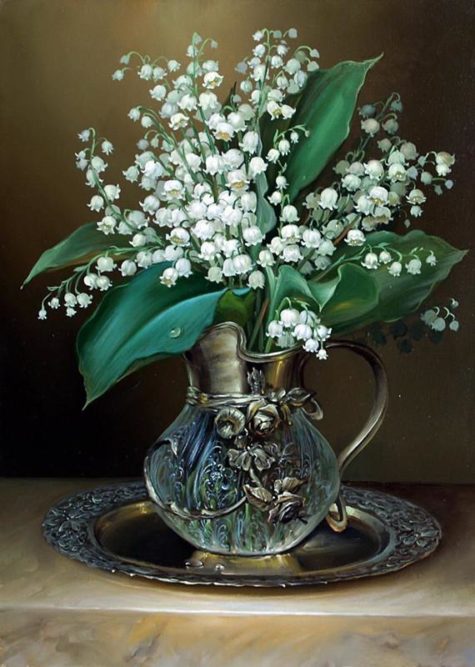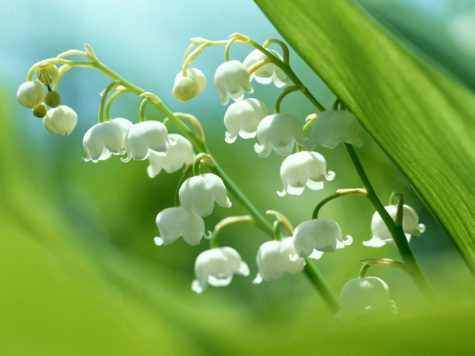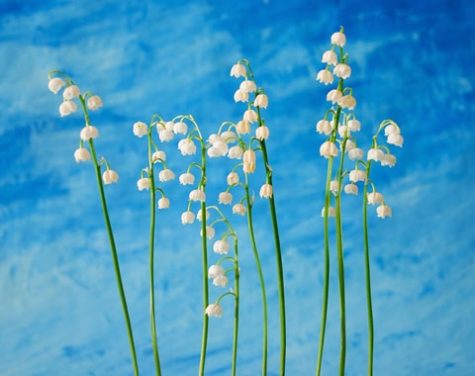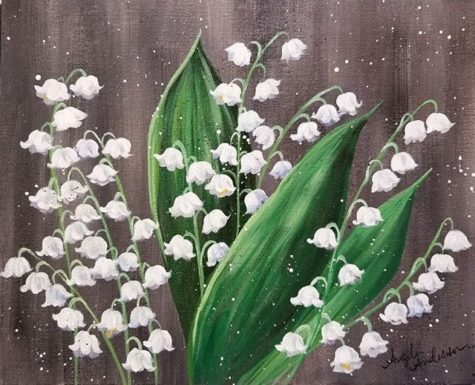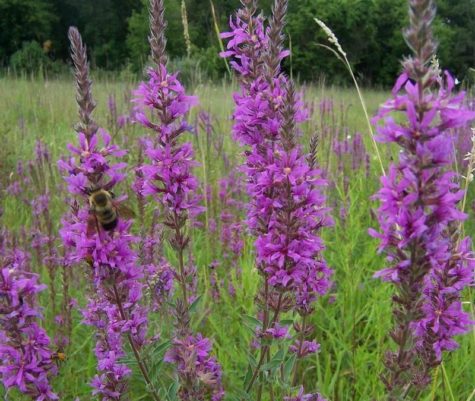Peace
- Parts Used: Fresh flowers
- Planet: Mercury
- Element: Air
- Magickal Influences: Peace, Conscious Mind, Memory, Attracts Fairies
Convallaria magalis, the botanical name for Lily of the Valley means “that which belongs to May,” making lily of the valley the recognized flower of the month of May, and thus, May birthdays. It is also the official flower of the zodiac sign Gemini.
This plant is also known as Little Maybells, May Bells, Mary’s Tears, Our Lady’s Tears, Jacob’s Ladder, Ladder to Heaven, Jacob’s Tear, May Lily, Convail Lily, Lily Constancy, Muguet, Male Lily, Convallaria, and Fairy Cups.
The well-known and dangerous effects of lily of the valley apply to its internal use, but not to its fragrance. Don’t eat, drink, add to your bath water, or rub into your skin.
Lily of the valley is a fragrant flowering plant used in religious ceremonies, world celebrations, perfumes and in gardens. Also known as the May lily, the name means “return to happiness” and most often symbolizes chastity, purity, happiness, luck and humility. Its meaning and symbolism are represented in Christian lore and folklore, on May Day, weddings and birthdays, and in various celebrations throughout the world.
This tiny plant produces sprays of white, bell-shaped flowers that emit what Culpeper calls a “pleasant, grateful scent.” The aroma instills peace and strengthens the conscious mind. With visualization, the scent will heighten your ability to recall old information and strengthen your powers of memory.
Although the cut flowers are occasionally available in florist shops in springtime, no true lily of the valley essential is available.
This European native plant was first cultivated in 1420 and is beloved by the Fae and humans alike. It is sometimes called Fairy Cups, because the flowers look like cups the fairies have hung up while dancing. The flowers are said to ring when fairies sing and to form ladders fairies use to reach reeds from which they weave their cradles. Obviously, this is a good plant for attracting the Folk to your magickal garden.
According to folklore, this plant blooms on the grave of someone who was executed for a crime they did not commit. It is thought that planting them in the garden will protect the home from ghosts and evil spirits. Although some people consider it bad luck to bring the flowers into the house, in France, people still trade gifts of this plant on May Day in order to have good luck through the year.
The scent of this flower is said to attract nightingales and to give people the power to see a better world.
In the language of flowers, Lily of the Valley means return of happiness, purity of heart, sweetness, tears of the Virgin Mary, you’ve made my life complete, humility, happiness, love’s good fortune. One legend of the lily of the valley is that it sprang from Eve’s tears when she was kicked out of the Garden of Eden.
As a symbol of chastity, purity, modesty and happiness, lily of the valley has been a popular wedding flower since the Middle Ages. According to legend, its strong fragrance lures the nightingale to find his mate. For some brides, the flower is the fifth item carried during a wedding, along with something old, new, borrowed and blue. In Holland, the flower is planted in a newlywed couple’s garden as a symbol of the renewal of love.
Lily of the valley is supposed to protect gardens from evil spirits and is known to have been used as a charm against witches’ spells. It is also considered the flower of fairies, its tiny bells used as cups from which to drink.
Some European countries believe lily of the valley prompts visions of heaven, aiding man to see a brighter future. In Germany and Scandinavia, the flower is a springtime symbol of good luck. In England, when St. Leonard of Sussex fought his grievous great battle with a dragon during the sixth century, as a commemoration to his efforts, the flowers are believed to have sprung from the ground where his blood spilled.
It is also believed that the flower is in honor of Maia, the daughter of the mythological Atlas, the oldest of the Seven Sisters and the goddess of growth, increase, fields, and spring. She and Zeus are the parents of Hermes (Mercury), and so she is the grandmother of magick, which was invented by her son Hermes. The month of May is named for her, and the 1st and 15th of May are her sacred days. Her worship survives as the celebration of the Queen of May in the Catholic church. In the past, only women were allowed to worship Maia. In ancient Rome, May was a time of purification and religious rituals, so it was a very unlucky month to get married (pretty interesting considering that nowadays lilies-of-the-valley are a standard in the bridal bouquet and represent marital longevity).
Lily of the valley is associated with Gemini because of the Mercury (Hermes) connection. Gemini rules divination and summoning, and since Mercury rules magick, this is a good plant to use for ceremonial magick or divination. You could make a great oil for aiding divination by macerating (soaking) the flowers in almond or olive oil. Make a number of macerations in the same oil to get a good buildup of scent. The lily of the valley perfumes commonly available are made from synthetics. Growing the plant is the only way to acquire a natural perfume of the flowers.
On May 1, 1561, King Charles IX received lily of the valley as a gift of luck and continued the tradition every first of May by giving the women of his court this fragrant flower. Today, every year in France, bunches of lily of the valley are sold on streets. In some cities, on May Day, folks wear a sprig in their clothing. The flower is also a symbol used on International Worker’s Day (also known as May Day), or Labor Day as it is known in the United States. The Finnish girl’s name Kielo means lily of the valley. It is also Finland’s national flower.
Considered a Mercury herb, lily of the valley was in the past used for illnesses of the head or brain, such as melancholy, depression, epilepsy, and stroke. Its decoction was mixed with lavender and peppercorns and spread on the forehead and back of the neck to bring someone to their senses. However, later it became much used as a far less poisonous substitution for foxglove and applied to heart disease. Historically, Germans have made a raisin wine with some of the flowers. This demonstrates that although the plant is toxic, the poison is poorly absorbed. The sap can be a skin irritant, however. Leaves of this plant furnish a green dye in spring and yellow in autumn.
The sweet, bee-attracting flowers appear in May; folk belief says plant tomatoes when you see them appear. It makes a great groundcover around shrubs, especially under lilacs (blooms at the same time). This is a good plant for the corners of your house, where nothing else will grow. It produces berries but reproduces mainly through creeping rhizomes.
Information collected from various sources.
- Basic Powers: To bring events to culmination.
- Pronunciation: “yare-awe”
Comfort; harmony with others. A symbol of right thoughts and right action leading to right results, a culmination of efforts over a long period of time. It is also good for gardening, farming, having a happy home, and good times. Put Jera over the door of your house on New Year’s Eve. Use indelible ink because the luck is meant to last as long as Jera remains there.
Jera is the rune of the harvest, of rewards arriving at their proper tine. It also governs legalities of all sorts and is useful in all legal matters. Use when a tangible result is expected for an outlay of money, time or effort. Helps to bring events to pass. Helps in legal matters. Fertility.
Fertility, creativity. Peace, harmony. Enlightenment. Realization of the cyclical nature of the multiverse. Realization of the mystery of the omnipresent circumference. Bringing other concepts into material manifestation.
The Chant
jera jera jera
j j j e e e r r r a a a
j j j j j j j j j
ju ja ji je jo
(jur jar jir jer jor)
j j j e e e r r r a a a
It can be used in conjunction with the symbol, or chanted while visualizing the symbol. The symbol can be etched into a candle while intoning the chant, and then, as the candle burns, the spell is released and sent.
The Statement of Intent:
The sky wolves have retreated;
Sunna warms the land below.
Freyr and Freya have
bestowed upon us a great bounty
for all the folk.
This is a modern version of the “Rune Poem” that defines this particular rune. It can be used in combination with the chant, and while creating a talisman or spell that uses the power of this rune.
Runic Posture
Rune Yoga, or Runic postures are used to anchor the energy of the Rune in your physical body. More about them can be found here: Runic Postures.
Assume the recommended runic posture and sing the name of the rune in a non-exhaustive way that you can feel your body vibrating – in magic literature it is called vibrating. It could be that you can hear overtones clearer as usual during vibrating. Take this as a good sign. You are visualizing the rune with your inner eye, as its form is being represented by your body and the energies are flowing through your body.
Stand up straight with your left arm bent, left hand at your waist. Your right arm is brought up to your head. Bend the elbows as shown in the image above.
Before practicing a rune it is recommended to know everything on the powers of the rune you want to practice. The flow of energy is different for each rune, a field of research for your sensitivity.
The hand positions, or mudras are effective only after you have anchored the runes in your own aura and body. They can be made silent and unobtrusive.
Sources:
- Understanding Runes
- Asatru
- Futhark
- Flight of the Condor
- A Practical Guide to the Runes
- Esoteric Rune Magic
- Latin names: Lythrum salicaria
- Common names: Spiked loosestrife, Purple lythrum, Flowering Sally
- Gender: Feminine
- Planet: Moon
- Element: Earth
- Parts Used: Flower, leaf and stem, root
- Powers: Peace, protection
Magical Uses:
Placed in the corners of each room, this herb restores harmony and brings peace. Give to a friend to help settle an argument. Brings about protection and peaceful energies when placed in the home.
This plant was considered most powerful when gathered on the Summer Solstice. One could control demons and troublesome spirits with the root if the following words were chanted over it before a sacred image:
Tear-weed, tear-weed
You have wept long and much but gained little.
May your tears not drown the open field
Nor your cries sound over the deep blue sea.
Frighten off the demons and the witches!
If they do not submit to you,
then drown them in your tears!
If they run from your glance,
throw them over cliffs or into pits!
May my words be firm and strong
for hundreds of years!
Information collected from various sources
- Magickal Purpose: Emotion, healing, mental, calming, tranquility, sleep, peace, loyalty, good will, purifying and protection, hope, sincerity, truth and patience, Poet or Bard, communication mental, written and oral skills Sleep, twilight
- Magickal Uses: Water magick. Balance, healing, peace and patience, communications, health friendships, dreams, sleep, inspiration, harmony in the home, meditations. Since it is traditional to surround your magickal circle with candles representing each of the four directions, and since blue is the color of water (west) and sky (east), use a blue candle to represent either of these quarters.
Sensitivity, intellect, protection, calmness, benevolence, and wisdom are all invoked through the color blue. Eat blue foods, like blueberries, or blue corn, to alleviate stress. Burn blue candles to get out of harm’s way or bring a judgment in your favor. Visualize the color blue while taking a test, at it increases mental activity and relaxes and opens brain centers. Blue is a primary spiritual color; use it in rituals to obtain harmony, inner light, or peace. Blue is also a healing color and confers truth and guidance.
Variations of the color blue and their attributes:
- Royal Blue: Healing, Promotes laughter and joviality; loyalty; use to attract Jupiter energy, or whenever an influence needs to be increased.
- Light Blue: Healing, Spiritual color; helpful in devotional or inspirational meditations; brings peace and tranquility to the home; radiates Aquarius energy; employ where a situation must be synthesized.
- Dark blue: Healing, Spells for creativity, peace and communication. Also for deep meditation and karma work.
Here are the magickal correspondences for the color blue:
- Element: Water
- Direction: West
- Chakra: Fifth, Throat Chakra
- Planets: Jupiter, Neptune, Mercury, Moon
- Days:
- Monday/Moon, Light Blues – peace, patience;
- Wednesday/Mercury, Blues – friendships, creativity, dreams;
- Thursday/Jupiter, Royal Blue – honor, happiness;
- Saturday/Saturn, Dark Blues – communication
- Number: 3
- Magickal Tools: Wand, Cauldron, Chalice
- Scent/Essential Oils: Lily of the Valley, Honeysuckle, Cedar, Basil, Jasmine, Sweetpea, Lotus
- Plant/Herbs: Carnation, Honeysuckle, Orange, Heather, Cypress, Hazel, Oak Moss, Mallow, Aloe Vera, Buttercup(communication), Daffodil and Baby’s Breath
- Tree/Wood: Cedar
- Animal: Dolphin, Whale, Mermaid, BlueJay, Gull, Giraffe, Robin, Deer, Ass, Clam, Lizard and the Frog
- Combinations: Use blue, black, and white together for change and easy transition
- Minerals/Stones: Azurite, Turquoise, Coral, Blue, Opal, Tanzanite, Sapphire, Chrysacola, Hematite, Sodalite, Blue Lace Agate, Lapis Lazuli (children), Aguamarine, Sapphire.
- Tarot Cards: The Heirophant, Cups
- Gods: Apollo, Asclepius, Bannick, Ceadda, Dabog, Dianceht, Esculapius, Forseti, Gucumatz, Hastehogan Lares, Kuan Ti, Penates, Tien Kuan
- Goddess: Alcyone, Aphrodite, Artemis, Bannick, Brigid, Cardea, Concordia, Dugnia, Eir, Gula, Harmonia, Hestia, Hygenia, Karusepas, Kedesh,Kikimora, Kwan Yin, Liban, Meditrina, Neith, Pax, Rhiannon, Salus, Vesta
- The Personality: Sensitivity, introspection, communication .This person has the sensitivity of a poet or an artist. Loves family and home. Is loyal, conscientious and observant. Also, may be a little more psychic than he/she believes themselves to be.
Collected from various sources including The Encyclopedia of Magickal Ingredients and realmagick.com
